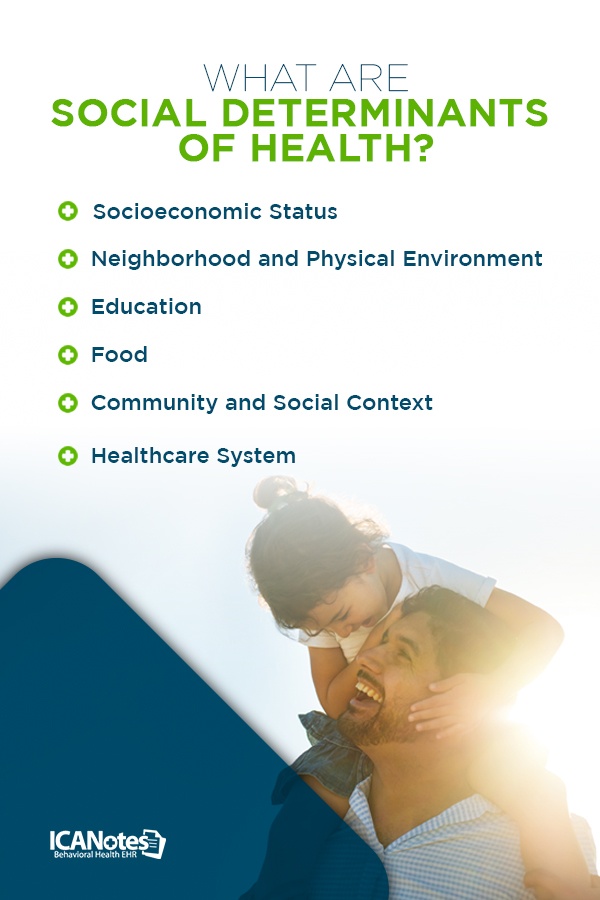What Are Social Determinants of Health (SDOH) and Why Are They Important?
When we seek to improve health in America, we usually look at the healthcare system. However, health in the U.S. is impacted by more factors than the healthcare system alone, including social, environmental and economic factors. These factors impact a person’s physical and mental well-being, along with their ability to access quality health care.
If we want to improve health and the healthcare system in America, addressing social determinants of mental health and behavioral health is a vital part of the process. Clinicians should know what social determinants are, how they can impact their patients’ health and how to address them.
Table of Contents
- What Are Social Determinants of Health?
- What Is Health Equity?
- How Do Social Determinants of Health Impact Mental Health Care?
- Addressing SDOH for Behavioral Health
- Screening for SDOH in Behavioral and Mental Health Care
- Document SDOH With ICANotes
What Are Social Determinants of Health?
Social determinants of health refer to the conditions people experience when they are born, grow, work and age that shape their health. To reduce longstanding disparities that exist in American health care, we need to address these social determinants of health.
There are six social determinants of health:
1. Socioeconomic Status
While determining a person’s socioeconomic status can be a nuanced process, there are certain factors we can use to measure it, such as:
- Employment
- Income
- Support
- Debt
- Expenses
- Medical bills
2. Neighborhood and Physical Environment
The environment and location in which an individual grows up can have a significant impact on their health as an adult. While the physical location in which a person grows up has a large impact on them, several other factors may come into play as well, including:
- Housing
- Safety
- Geography and zip code
- Transportation
- Walkability
- Parks
- Playgrounds
3. Education
Education also plays a significant role in determining someone’s health. From early childhood to higher education, several factors determine someone’s education and how it relates to their overall health — these factors include:
- Early childhood education
- Language
- Literacy
- Higher education
- Vocational training
4. Food
It’s no secret that food and health are related. While making healthy food choices is an essential part of staying healthy, there are several other food-related factors that determine a person’s overall health, including:
- Hunger
- Access to healthy food options
5. Community and Social Context
The ways in which a person interacts with their community also has a large impact on their health and well-being. When people have a strong sense of community, they tend to be healthier overall. Some other factors of community and social context to consider are:
- Support systems
- Social integration
- Community engagement
- Stress
- Discrimination
6. Healthcare System
Of course, a person’s access to health care directly impacts their health. However, there are several facets of health care to consider when analyzing the intersections between health care and a person’s overall health — these include:
- Health coverage
- Quality of care
- Provider cultural and linguistic competency
- Provider availability
Initiatives for addressing social determinants of health both in and out of the healthcare system are increasing in America. The purpose of these initiatives is to shape the practices and policies in non-health sectors to promote health and health equity.
What Is Health Equity?
Although health equity is a widely used term, understanding of the term is lacking. Health equity means everyone is given a fair and just opportunity to reach their highest possible level of health.
As such, health equity requires the removal of health obstacles, such as discrimination and poverty, and the consequences of these obstacles. These obstacles include a lack of access to quality education, safe environments, quality housing, jobs with fair pay and quality health care.
Achieving health equity requires the following steps:
-
- Identifying health disparities: Inequities in resources and opportunities are often the root of disparities in health. Increases in opportunities among social determinants of health can give people a chance to be healthier, which benefits Americans as a whole. Groups that have been historically marginalized or excluded should receive particular focus.
- Changing systems to reduce inequities: To eliminate unfair institutional and individual social conditions that lead to inequities, we need to change systems and implement laws, policies and practices that can reduce these inequities.
- Evaluating efforts: We need to use short-term and long-term measures to monitor the effects of the initiatives we implement to reduce inequities and health disparities.
- Reassessing strategies: As we evaluate and monitor our efforts, we need to reassess our strategies to ensure we are addressing health disparities in the most effective way.
Equity is not the same as equality. Equality is treating everyone the same, while equity means providing people what they need so they can be successful, which often means giving more to those who need it. People should be valued equally, but existing social determinants should also be taken into consideration to improve their health.
How Do Social Determinants of Health Impact Mental Health Care?
Mental health is a concern for people of any age. Among children, mental health disorders can lead to a variety of negative outcomes, including:
- Failure in school
- Family conflict
- Violence
- Alcohol or drug abuse
- Suicide
Social determinants of health can impact mental health care. When providers use social determinant interventions, people enjoy better mental health outcomes, but tracing connections between individual mental health and social determinants can be tricky.
Social Determinants of Mental Health
The first step of understanding the social determinants of mental health is knowing what populations may be more vulnerable to these social determinants than others. The following are some social determinants of health that impact mental health care:
- Age
- Race
- Ethnicity
- Gender
- Education level
- Income level
- Geographic location
- Quality of housing
- Interpersonal and community dynamics
- School and work conditions
- Employment opportunities
These factors can have negative or positive effects on mental health and risk. While an impoverished area with a high crime rate can have a negative impact on mental health, safe shared spaces like parks can promote positive mental health.
Addressing Social Determinants’ Impact on Mental Health
What is being done to study and address the impact of social determinants of health in the mental health field? One method is providing funds to medical schools and nonprofit organizations, so they can use an approach in their healthcare programs that focuses on social determinants.
Even health providers who don’t specialize in mental health can address social determinants when caring for patients. By abandoning the assumption that institutions can only perform a certain function, we open ourselves up to the effects that a person’s environment, work and living situation can have on their mental health.
Gender, race and class are also social determinants of mental health — these factors affect language barriers, residential segregation and social norms. Though a social determinant can be a difficult factor to immediately measure, it can still have a significant, long-term effect. Factors that contribute to how prevalent a chronic disease is, for example, may not be uncovered for decades or even generations — this amount of time is challenging to study, but doing so is necessary so we can address social determinants.
How a Natural Disaster Can Impact Mental Health
Once we are finally equipped to recognize evidence of social determinants, we can make the crisis more widely visible and begin to address social issues more effectively. Natural disasters often bring a magnifying glass to a community’s social determinants, showing us what makes this group vulnerable. The impact of these disasters on mental health is long-term, and the impact can usually be traced for several years after, especially for more vulnerable populations like low-income residents.
Moments of crisis tend to illuminate systems of inequality. Unfortunately, this is sometimes what a community needs for the bigger systems to address the issues this community is facing. The preventive services that follow a crisis can enrich a community and improve the group’s general and mental health.

Mental health practitioners can provide more effective care to their patients by being knowledgeable about social determinants of health and how they can impact a patient’s mental well-being.
Addressing SDOH for Behavioral Health
How can practitioners in mental and behavioral health address social determinants of health? Health care is just one of many health determinants. To get a comprehensive idea of a patient’s health, providers need to be addressing social determinants of health.
Though there isn’t currently a consensus on how much each of these factors proportionally contributes to health, many studies have shown that health behaviors like exercise, diet and smoking, along with economic and social factors, drive health outcomes. Economic and social factors shape how an individual behaves and lead them to protective or destructive health behaviors.
When a person doesn’t complete high school, for example, their children are more likely to face barriers, such as substandard housing, a lack of safety and exposed garbage. They’re less likely to live in an area with access to:
- Libraries
- Recreation centers
- Parks
- Playgrounds
- Sidewalks
Another example is stress, which can have a significant negative impact on health throughout a person’s life. Additionally, environmental factors can impact multiple generations. Not only is addressing SDOH crucial for improving health, but it’s also necessary for reducing the health disparities rooted in economic and social disadvantages.
So, how are we addressing social determinants of health? Initiatives are emerging to increase our focus on health within non-health sectors and to address environmental and social factors in the healthcare system that impact health.
The healthcare system can’t be our only focus if we want to improve health and health equity — we also need to address non-health sectors and their policies and practices. What is the accessibility and availability of affordable healthy foods, public transportation and health care? For example, public transportation can impact an individual’s ability to access employment.
The following are examples of ways to address the availability and accessibility of affordable healthy food:
- Nutrition programs that support healthier stores in low-income neighborhoods
- School gardens
- Community gardens
- Farm to school programs
- Support for the production of healthy foods
Another approach involves incorporating considerations about health into multiple policies and sectors and addressing how improved health can also support the goals of these sectors. Those in the sectors promote health, sustainability and equity, while also making progress toward other goals like economic stability, job creation and access to transportation.
Organizations like the CDC and the World Health Organization are also working to reduce health inequities and address social determinants of health by improving conditions of daily life, tackling inequitable distribution of resources and raising public awareness.
Screening for SDOH in Behavioral and Mental Health Care
Why is it important for behavioral health practitioners to screen for social determinants of health? Social determinants of health can impact every facet of an individual’s life, even in ways that may not seem obviously influenced by health, such as:
- Job opportunities
- Accessibility of food
- Residential segregation
- Incarceration
- Access to emerging technologies
Without screening for social determinants of health, physicians are far more limited in the care they can provide.
How Screening for Social Determinants Benefits Practitioners
How does screening for social determinants of health benefit health practitioners? Systematic screening for social determinants of health and basic needs can help physicians provide better care and helpful referrals to their patients. For example, a physician can screen for the following during a well-child visit:
- Food security
- Child care
- Housing
- Household heat
- Parent education
- Parent employment
After screening for these basic needs, a provider can then supply the family with referrals to helpful community resources, such as child care, maternal employment and family support services.
Because of the growing awareness of the need to screen for social determinants of health, practitioners are receiving the training and tools needed to improve their practices. Other sectors are also working in collaboration with the healthcare sector to emphasize health, which could help clinicians encourage healthy behaviors among their patients.
How to Screen for SDOH
How do health practitioners screen for social determinants of health? The first step to addressing social determinants of health is by asking patients if they are facing any social challenges in a caring, sensitive manner.
As a practitioner, you may need to ask patients about food insecurity, lack of employment, discrimination or barriers to making healthcare appointments. A question as simple as, “Do you have trouble making ends meet?” can help you identify if a patient is struggling financially or living below the poverty line.
When clinicians show empathy and compassion, patients are more likely to be forthcoming about the struggles they are facing and their concerns.
Document SDOH With ICANotes
Social determinants of health can have a significant impact on a patient’s mental and behavioral health. Being able to identify and address social determinants can greatly improve the effectiveness of the care clinicians provide.
As a healthcare provider, you should screen for social determinants of health when caring for your patients, which can lead to even more necessary documentation. Now that the job of a healthcare provider has become more demanding and stressful than ever, many clinicians are looking for a solution that can make the documentation process easier and faster.
ICANotes can make behavioral health documentation a faster, more comprehensive process. Start your free trial or watch a live demo to see how ICANotes works.
Related Posts
How Does Mental Illness Among the Elderly Go Undiagnosed?Understanding the Mental Health Crisis Facing Today’s Youth
Addressing Mental Health Issues in School Leads to Improved Performance
Most Common Industries Affected by Mental and Behavioral Health Issues
Supporting Seniors’ Mental Health Throughout the Aging Process




